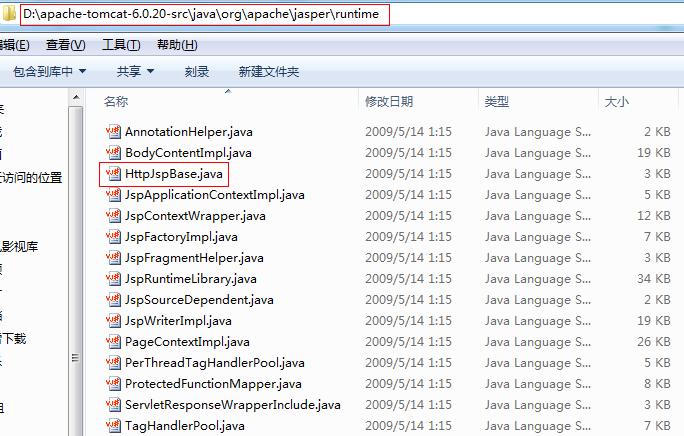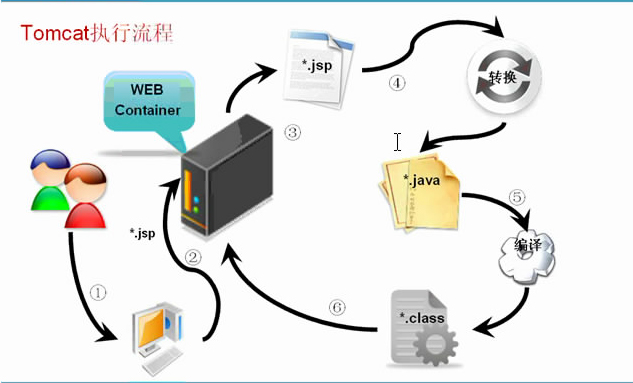JSP動態網頁開發原理詳解
一、什么是JSP?
JSP全稱是Java Server Pages,它和servle技術一樣,都是SUN公司定義的一種用于開發動態web資源的技術。
JSP這門技術的最大的特點在于,寫jsp就像在寫html,但它相比html而言,html只能為用戶提供靜態數據,而Jsp技術允許在頁面中嵌套java代碼,為用戶提供動態數據。
二、JSP原理
2.1、Web服務器是如何調用并執行一個jsp頁面的?
瀏覽器向服務器發請求,不管訪問的是什么資源,其實都是在訪問Servlet,所以當訪問一個jsp頁面時,其實也是在訪問一個Servlet,服務器在執行jsp的時候,首先把jsp翻譯成一個Servlet,所以我們訪問jsp時,其實不是在訪問jsp,而是在訪問jsp翻譯過后的那個Servlet,例如下面的代碼:
index.jsp
<%@ page language="java" import="java.util.*" pageEncoding="UTF-8"%><%String path = request.getContextPath();String basePath = request.getScheme()+"://"+request.getServerName()+":"+request.getServerPort()+path+"/";%><!DOCTYPE HTML PUBLIC "-//W3C//DTD HTML 4.01 Transitional//EN"><html> <head> <base href="<%=basePath%>" rel="external nofollow" > <title>First Jsp</title> </head> <body> <% out.print("Hello Jsp"); %> </body></html>當我們通過瀏覽器訪問index.jsp時,服務器首先將index.jsp翻譯成一個index_jsp.class,在Tomcat服務器的work\Catalina\localhost\項目名\org\apache\jsp目錄下可以看到index_jsp.class的源代碼文件index_jsp.java,index_jsp.java的代碼如下:
package org.apache.jsp;import javax.servlet.*;import javax.servlet.http.*;import javax.servlet.jsp.*;import java.util.*;public final class index_jsp extends org.apache.jasper.runtime.HttpJspBase implements org.apache.jasper.runtime.JspSourceDependent { private static final JspFactory _jspxFactory = JspFactory.getDefaultFactory(); private static java.util.List _jspx_dependants; private javax.el.ExpressionFactory _el_expressionfactory; private org.apache.AnnotationProcessor _jsp_annotationprocessor; public Object getDependants() { return _jspx_dependants; } public void _jspInit() { _el_expressionfactory = _jspxFactory.getJspApplicationContext(getServletConfig().getServletContext()).getExpressionFactory(); _jsp_annotationprocessor = (org.apache.AnnotationProcessor) getServletConfig().getServletContext().getAttribute(org.apache.AnnotationProcessor.class.getName()); } public void _jspDestroy() { } public void _jspService(HttpServletRequest request, HttpServletResponse response) throws java.io.IOException, ServletException { PageContext pageContext = null; HttpSession session = null; ServletContext application = null; ServletConfig config = null; JspWriter out = null; Object page = this; JspWriter _jspx_out = null; PageContext _jspx_page_context = null; try { response.setContentType("text/html;charset=UTF-8"); pageContext = _jspxFactory.getPageContext(this, request, response, null, true, 8192, true); _jspx_page_context = pageContext; application = pageContext.getServletContext(); config = pageContext.getServletConfig(); session = pageContext.getSession(); out = pageContext.getOut(); _jspx_out = out; out.write("\r"); out.write("\n");String path = request.getContextPath();String basePath = request.getScheme()+"://"+request.getServerName()+":"+request.getServerPort()+path+"/"; out.write("\r\n"); out.write("\r\n"); out.write("<!DOCTYPE HTML PUBLIC \"-//W3C//DTD HTML 4.01 Transitional//EN\">\r\n"); out.write("<html>\r\n"); out.write(" <head>\r\n"); out.write(" <base href=\""); out.print(basePath); out.write("\">\r\n"); out.write(" \r\n"); out.write(" <title>First Jsp</title>\r\n"); out.write("\t\r\n"); out.write(" </head>\r\n"); out.write(" \r\n"); out.write(" <body>\r\n"); out.write(" "); out.print("Hello Jsp"); out.write("\r\n"); out.write(" </body>\r\n"); out.write("</html>\r\n"); } catch (Throwable t) { if (!(t instanceof SkipPageException)){ out = _jspx_out; if (out != null && out.getBufferSize() != 0) try { out.clearBuffer(); } catch (java.io.IOException e) {} if (_jspx_page_context != null) _jspx_page_context.handlePageException(t); } } finally { _jspxFactory.releasePageContext(_jspx_page_context); } }}我們可以看到,index_jsp這個類是繼承 org.apache.jasper.runtime.HttpJspBase這個類的,通過查看Tomcat服務器的源代碼,可以知道在apache-tomcat-6.0.20-src\java\org\apache\jasper\runtime目錄下存HttpJspBase這個類的源代碼文件,如下圖所示:

我們可以看看HttpJsBase這個類的源代碼,如下所示:
/* * Licensed to the Apache Software Foundation (ASF) under one or more * contributor license agreements. See the NOTICE file distributed with * this work for additional information regarding copyright ownership. * The ASF licenses this file to You under the Apache License, Version 2.0 * (the "License"); you may not use this file except in compliance with * the License. You may obtain a copy of the License at * * http://www.apache.org/licenses/LICENSE-2.0 * * Unless required by applicable law or agreed to in writing, software * distributed under the License is distributed on an "AS IS" BASIS, * WITHOUT WARRANTIES OR CONDITIONS OF ANY KIND, either express or implied. * See the License for the specific language governing permissions and * limitations under the License. */package org.apache.jasper.runtime;import java.io.IOException;import javax.servlet.ServletConfig;import javax.servlet.ServletException;import javax.servlet.http.HttpServlet;import javax.servlet.http.HttpServletRequest;import javax.servlet.http.HttpServletResponse;import javax.servlet.jsp.HttpJspPage;import javax.servlet.jsp.JspFactory;import org.apache.jasper.compiler.Localizer;/** * This is the super class of all JSP-generated servlets. * * @author Anil K. Vijendran */public abstract class HttpJspBase extends HttpServlet implements HttpJspPage{ protected HttpJspBase() { } public final void init(ServletConfig config) throws ServletException { super.init(config); jspInit(); _jspInit(); } public String getServletInfo() { return Localizer.getMessage("jsp.engine.info"); } public final void destroy() { jspDestroy(); _jspDestroy(); } /** * Entry point into service. */ public final void service(HttpServletRequest request, HttpServletResponse response) throws ServletException, IOException { _jspService(request, response); } public void jspInit() { } public void _jspInit() { } public void jspDestroy() { } protected void _jspDestroy() { } public abstract void _jspService(HttpServletRequest request, HttpServletResponse response) throws ServletException, IOException;}HttpJspBase類是繼承HttpServlet的,所以HttpJspBase類是一個Servlet,而index_jsp又是繼承HttpJspBase類的,所以index_jsp類也是一個Servlet,所以當瀏覽器訪問服務器上的index.jsp頁面時,其實就是在訪問index_jsp這個Servlet,index_jsp這個Servlet使用_jspService這個方法處理請求。
2.2、Jsp頁面中的html排版標簽是如何被發送到客戶端的?
瀏覽器接收到的這些數據
<!DOCTYPE HTML PUBLIC "-//W3C//DTD HTML 4.01 Transitional//EN"><html> <head> <base href="http://localhost:8080/JavaWeb_Jsp_Study_20140603/" rel="external nofollow" > <title>First Jsp</title> </head> <body> Hello Jsp </body></html>
都是在_jspService方法中使用如下的代碼輸出給瀏覽器的:
out.write("\r"); out.write("\n");String path = request.getContextPath();String basePath = request.getScheme()+"://"+request.getServerName()+":"+request.getServerPort()+path+"/"; out.write("\r\n"); out.write("\r\n"); out.write("<!DOCTYPE HTML PUBLIC \"-//W3C//DTD HTML 4.01 Transitional//EN\">\r\n"); out.write("<html>\r\n"); out.write(" <head>\r\n"); out.write(" <base href=\""); out.print(basePath); out.write("\">\r\n"); out.write(" \r\n"); out.write(" <title>First Jsp</title>\r\n"); out.write("\t\r\n"); out.write(" </head>\r\n"); out.write(" \r\n"); out.write(" <body>\r\n"); out.write(" "); out.print("Hello Jsp"); out.write("\r\n"); out.write(" </body>\r\n"); out.write("</html>\r\n");在jsp中編寫的java代碼和html代碼都會被翻譯到_jspService方法中去,在jsp中編寫的java代碼會原封不動地翻譯成java代碼,如<%out.print("Hello Jsp");%>直接翻譯成out.print("Hello Jsp");,而HTML代碼則會翻譯成使用out.write("<html標簽>\r\n");的形式輸出到瀏覽器。在jsp頁面中編寫的html排版標簽都是以out.write("<html標簽>\r\n");的形式輸出到瀏覽器,瀏覽器拿到html代碼后才能夠解析執行html代碼。
2.3、Jsp頁面中的java代碼服務器是如何執行的?
在jsp中編寫的java代碼會被翻譯到_jspService方法中去,當執行_jspService方法處理請求時,就會執行在jsp編寫的java代碼了,所以Jsp頁面中的java代碼服務器是通過調用_jspService方法處理請求時執行的。
2.4、Web服務器在調用jsp時,會給jsp提供一些什么java對象?
查看_jspService方法可以看到,Web服務器在調用jsp時,會給Jsp提供如下的8個java對象
PageContext pageContext;HttpSession session;ServletContext application;ServletConfig config;JspWriter out;Object page = this;HttpServletRequest request,HttpServletResponse response
其中page對象,request和response已經完成了實例化,而其它5個沒有實例化的對象通過下面的方式實例化
pageContext = _jspxFactory.getPageContext(this, request, response,null, true, 8192, true); application = pageContext.getServletContext(); config = pageContext.getServletConfig(); session = pageContext.getSession(); out = pageContext.getOut();
這8個java對象在Jsp頁面中是可以直接使用的,如下所示:
<% session.setAttribute("name", "session對象");//使用session對象,設置session對象的屬性 out.print(session.getAttribute("name")+"<br/>");//獲取session對象的屬性 pageContext.setAttribute("name", "pageContext對象");//使用pageContext對象,設置pageContext對象的屬性 out.print(pageContext.getAttribute("name")+"<br/>");//獲取pageContext對象的屬性 application.setAttribute("name", "application對象");//使用application對象,設置application對象的屬性 out.print(application.getAttribute("name")+"<br/>");//獲取application對象的屬性 out.print("Hello Jsp"+"<br/>");//使用out對象 out.print("服務器調用index.jsp頁面時翻譯成的類的名字是:"+page.getClass()+"<br/>");//使用page對象 out.print("處理請求的Servlet的名字是:"+config.getServletName()+"<br/>");//使用config對象 out.print(response.getContentType()+"<br/>");//使用response對象 out.print(request.getContextPath()+"<br/>");//使用request對象%>運行結果如下:

2.5、Jsp最佳實踐
Jsp最佳實踐就是jsp技術在開發中該怎么去用。
不管是JSP還是Servlet,雖然都可以用于開發動態web資源。但由于這2門技術各自的特點,在長期的軟件實踐中,人們逐漸把servlet作為web應用中的控制器組件來使用,而把JSP技術作為數據顯示模板來使用。其原因為,程序的數據通常要美化后再輸出:讓jsp既用java代碼產生動態數據,又做美化會導致頁面難以維護。讓servlet既產生數據,又在里面嵌套html代碼美化數據,同樣也會導致程序可讀性差,難以維護。因此最好的辦法就是根據這兩門技術的特點,讓它們各自負責各的,servlet只負責響應請求產生數據,并把數據通過轉發技術帶給jsp,數據的顯示jsp來做。
2.6、Tomcat服務器的執行流程

第一次執行:
- 客戶端通過電腦連接服務器,因為是請求是動態的,所以所有的請求交給WEB容器來處理
- 在容器中找到需要執行的*.jsp文件
- 之后*.jsp文件通過轉換變為*.java文件
- *.java文件經過編譯后,形成*.class文件
- 最終服務器要執行形成的*.class文件
第二次執行:
因為已經存在了*.class文件,所以不在需要轉換和編譯的過程
修改后執行:
1.源文件已經被修改過了,所以需要重新轉換,重新編譯。
到此這篇關于JSP動態網頁開發原理詳解的文章就介紹到這了,更多相關JSP動態網頁開發原理內容請搜索以前的文章或繼續瀏覽下面的相關文章希望大家以后多多支持!
相關文章:

 網公網安備
網公網安備